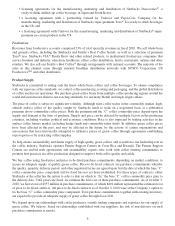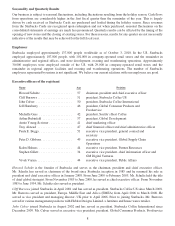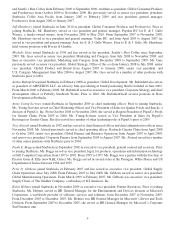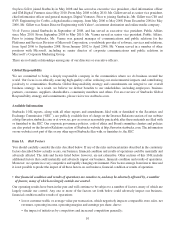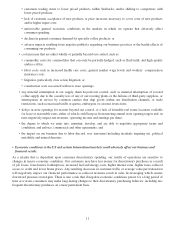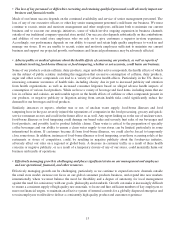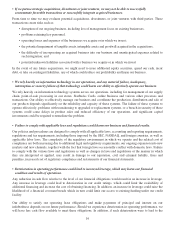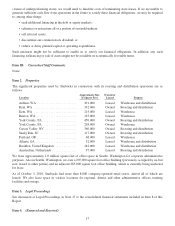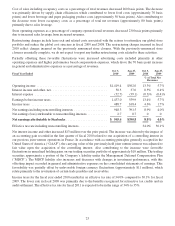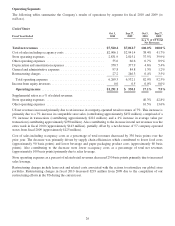Starbucks 2010 Annual Report Download - page 22
Download and view the complete annual report
Please find page 22 of the 2010 Starbucks annual report below. You can navigate through the pages in the report by either clicking on the pages listed below, or by using the keyword search tool below to find specific information within the annual report.•If we pursue strategic acquisitions, divestitures or joint ventures, we may not be able to successfully
consummate favorable transactions or successfully integrate acquired businesses.
From time to time we may evaluate potential acquisitions, divestitures, or joint ventures with third parties. These
transactions create risks such as:
• disruption of our ongoing business, including loss of management focus on existing businesses;
• problems retaining key personnel;
• operating losses and expenses of the businesses we acquire or in which we invest;
• the potential impairment of tangible assets, intangible assets and goodwill acquired in the acquisitions;
• the difficulty of incorporating an acquired business into our business and unanticipated expenses related to
such integration; and
• potential unknown liabilities associated with a business we acquire or in which we invest
In the event of any future acquisitions, we might need to issue additional equity securities, spend our cash, incur
debt, or take on contingent liabilities, any of which could reduce our profitability and harm our business.
•We rely heavily on information technology in our operations, and any material failure, inadequacy,
interruption or security failure of that technology could harm our ability to effectively operate our business.
We rely heavily on information technology systems across our operations, including for management of our supply
chain, point-of-sale processing in our stores, Starbucks Cards, online business and various other processes and
transactions. Our ability to effectively manage our business and coordinate the production, distribution and sale of
our products depends significantly on the reliability and capacity of these systems. The failure of these systems to
operate effectively, problems with transitioning to upgraded or replacement systems, or a breach in security of these
systems could cause delays in product sales and reduced efficiency of our operations, and significant capital
investments could be required to remediate the problem.
•Failure to comply with applicable laws and regulations could harm our business and financial results.
Our policies and procedures are designed to comply with all applicable laws, accounting and reporting requirements,
regulations and tax requirements, including those imposed by the SEC, NASDAQ, and foreign countries, as well as
applicable labor laws. The complexity of the regulatory environment in which we operate and the related cost of
compliance are both increasing due to additional legal and regulatory requirements, our ongoing expansion into new
markets and new channels, together with the fact that foreign laws occasionally conflict with domestic laws. Failure
to comply with the various laws and regulations as well as changes in laws and regulations or the manner in which
they are interpreted or applied, may result in damage to our reputation, civil and criminal liability, fines and
penalties, increased cost of regulatory compliance and restatements of our financial statements.
•Deterioration in operating performance could lead to increased leverage, which may harm our financial
condition and results of operations.
Any reduction in cash flow relative to the level of our financial obligations would result in an increase in leverage.
Any increase in leverage could lead to deterioration in our credit ratings, which could limit the availability of
additional financing and increase the cost of obtaining financing. In addition, an increase in leverage could raise the
likelihood of a financial covenant breach which in turn could limit our access to existing funding under our credit
facility.
Our ability to satisfy our operating lease obligations and make payments of principal and interest on our
indebtedness depends on our future performance. Should we experience deterioration in operating performance, we
will have less cash flow available to meet these obligations. In addition, if such deterioration were to lead to the
16


